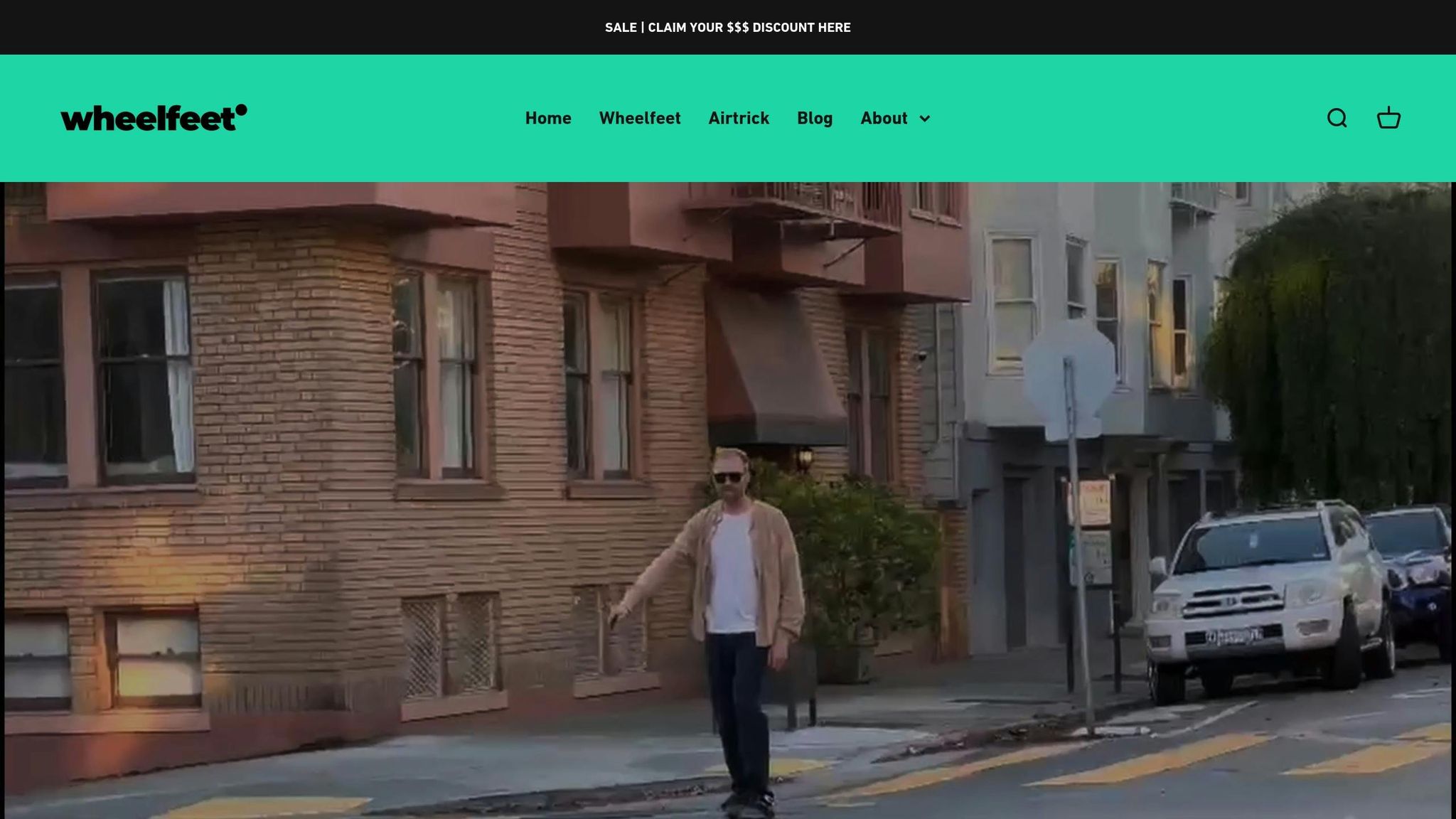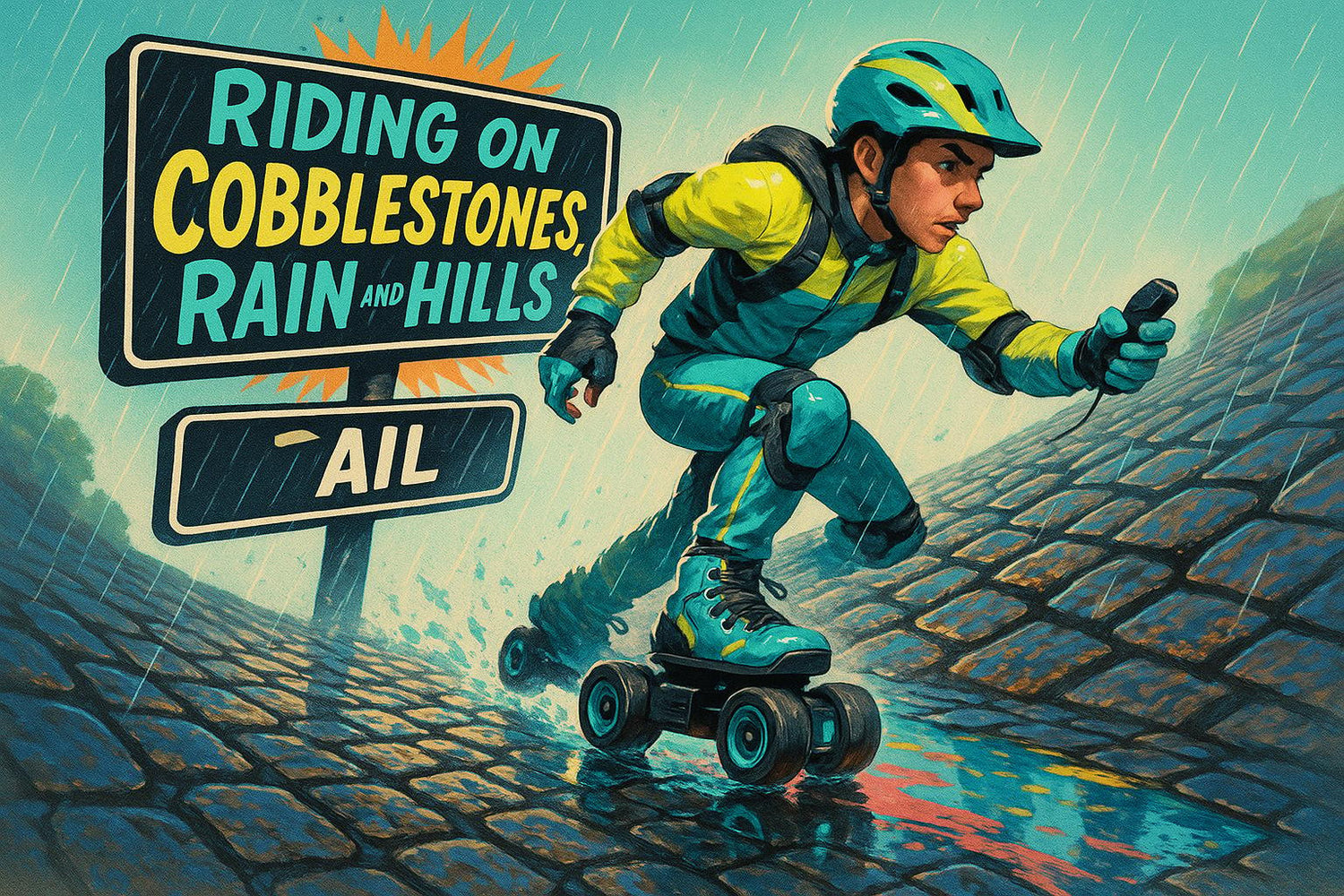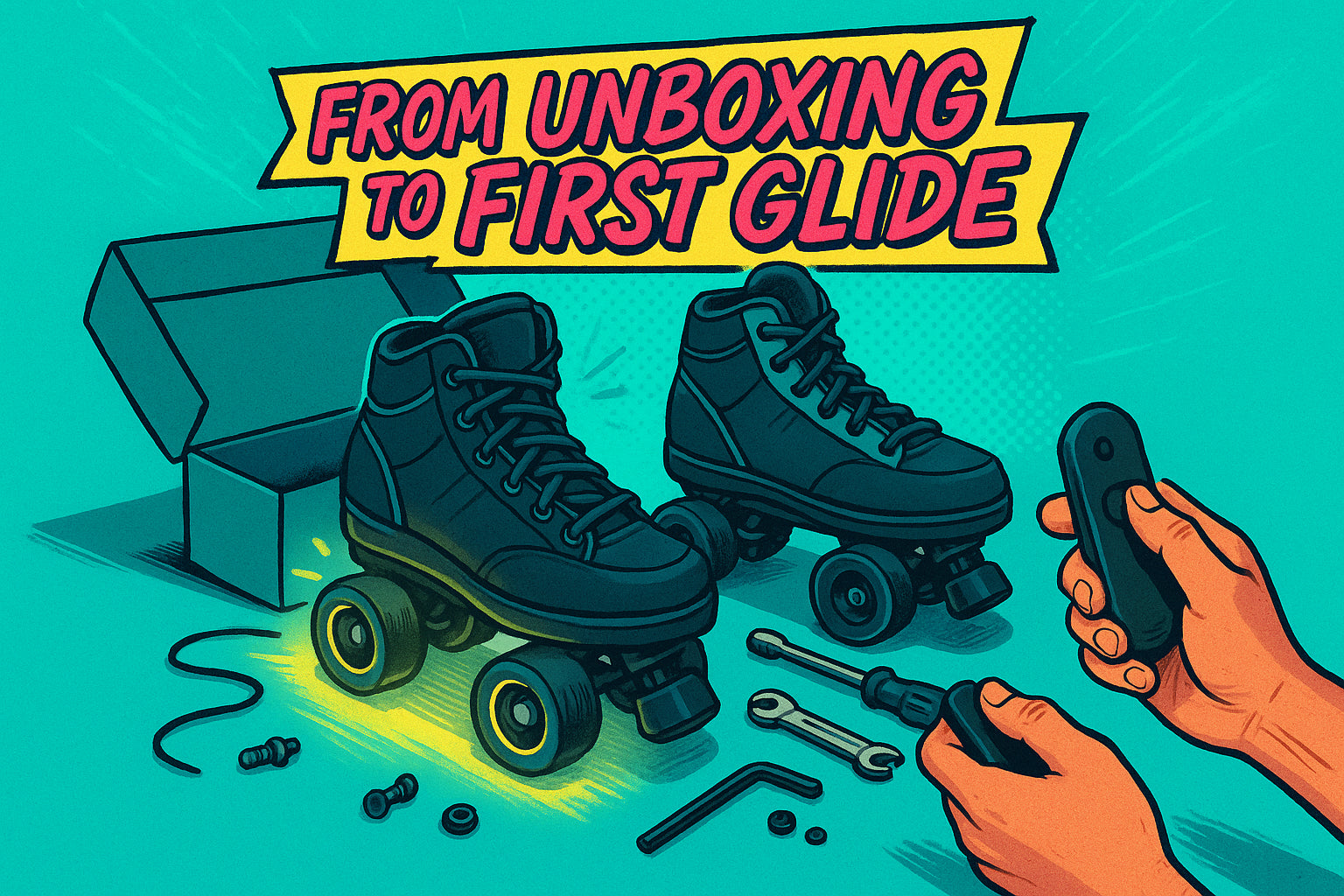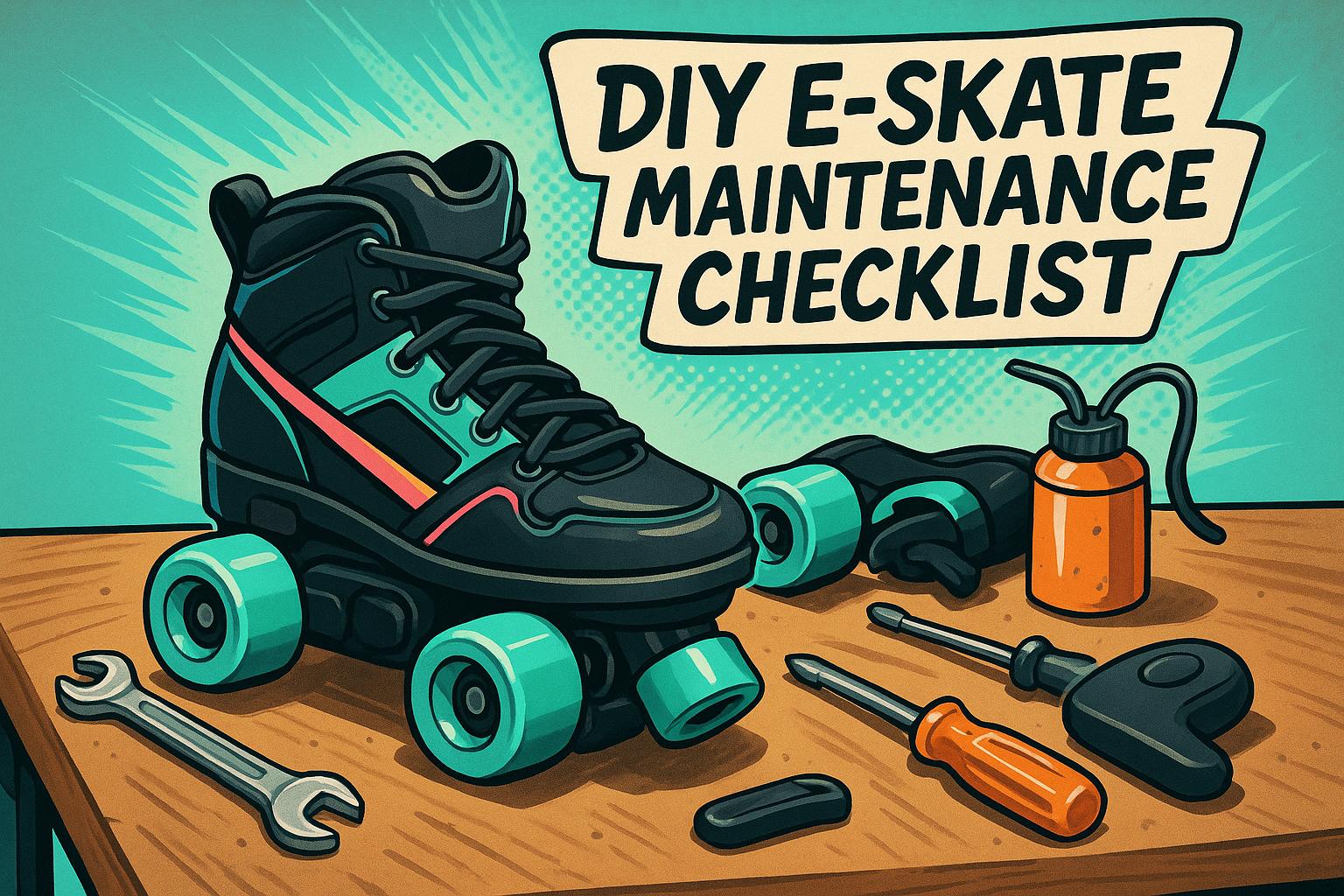Electric roller skating isn’t always smooth. Cobblestones, rain, and hills can make rides challenging, but with the right techniques and gear, you can handle these conditions confidently. This guide highlights how to adjust your posture, control speed, and maintain safety while using Wheelfeet electric roller skates, specifically designed for rough terrain. Key takeaways:
- Cobblestones: Bend your knees, distribute weight evenly, and approach curbs at an angle for smoother transitions.
- Rain: Use softer wheels for better traction, slow down, and avoid sharp turns. Protect your skates from water damage and ensure visibility with reflective gear.
- Hills: Use the wireless remote to manage speed and apply regenerative braking for controlled descents.
Safety gear like helmets, pads, and wrist guards is essential, along with regular skate maintenance to ensure peak performance. Whether you’re navigating uneven streets, slippery surfaces, or steep inclines, preparation and proper technique make all the difference.
About Wheelfeet Electric Roller Skates

Wheelfeet electric roller skates are designed to handle the challenges of urban landscapes. Whether you're gliding over cobblestone streets or navigating slick pavement after a rainstorm, these skates provide the stability and control you need to skate with confidence.
Unlike standard recreational skates, which are best suited for smooth surfaces, Wheelfeet skates are crafted to tackle rough terrain while keeping both safety and comfort in mind.
"Wheelfeet are sturdy and safe. The speed control is perfect, you can go fast, you can stop with it easily, I love them." - Engel
Their adjustable bindings ensure a secure fit, keeping your shoes firmly connected to the skates. This close connection is essential when you're rolling over uneven surfaces - it allows you to react quickly and stay balanced, even when the terrain gets tricky.
A powerful motor helps maintain momentum over bumps and cracks, ensuring a smoother ride overall.
These features come together to deliver exceptional performance on challenging surfaces.
Features for Difficult Terrain
Wheelfeet skates are built for more than just short rides - they’re equipped to handle rough terrain and longer commutes with ease. With a top speed of 15 mph, a 9-mile range, and larger wheels (motor: 2.83 inches, front: 2.7 inches), these skates glide over small obstacles like cracks, stones, or uneven pavement without jarring impacts.
The skates also feature dual-mode operation, allowing you to switch between electric and manual modes. This is especially useful for tricky sections where you need full control. Simply turn off the motor for traditional skating techniques, then power back up when the path evens out.
A durable aluminum frame adds to their rugged design. Aluminum strikes the perfect balance between strength and weight, providing a stable platform that won’t bend or flex under pressure, while remaining light enough for daily use.
On top of terrain-focused features, Wheelfeet skates include intuitive controls that make every ride smooth and enjoyable.
Speed Settings and Control Systems
A wireless remote gives you precise control over speed and braking, ensuring stability even on bumpy or uneven ground.
The regenerative braking system offers smooth and reliable stopping power, which is especially important on hills or slippery surfaces. Unlike traditional friction brakes that can grab suddenly or fail when wet, regenerative braking provides consistent deceleration while also recharging the battery, extending your range.
This blend of adjustable power delivery and responsive controls ensures the skates adapt to your needs. Whether you're accelerating gently on wet pavement or powering up a steep hill, Wheelfeet skates adjust seamlessly to match the conditions you're riding in.
How to Ride on Cobblestones and Rough Surfaces
Skating on cobblestones or uneven pavement is a completely different experience compared to gliding over smooth sidewalks. To handle these tricky surfaces, you’ll need to adjust your posture, control your speed, and choose the right wheels. Below, we’ll cover balance techniques, curb-crossing methods, and wheel selection to help you skate confidently on rough terrain.
Keeping Your Balance and Stability
When skating on uneven surfaces, bent knees are your best friend - they act like shock absorbers, helping you handle bumps and gaps. Keep your weight evenly distributed over both skates to avoid sudden jolts, and extend your arms slightly to make quick balance corrections easier.
Instead of making abrupt speed changes, rely on gradual adjustments to maintain stability. Sudden stops or accelerations can throw you off balance, especially on rough ground.
Keep your eyes focused ahead to anticipate obstacles like cracks or uneven patches. When you hit a bumpy section, shift your weight slightly toward your heels. This prevents your front wheels from catching on obstacles, allowing the stronger rear wheels to handle the impact more effectively. Building a solid sense of balance is key to tackling curbs and transitions with confidence.
How to Cross Curbs and Transitions Safely
Navigating curbs and transitions requires a thoughtful approach to maintain control. Rather than skating straight at a curb, approach it at an angle. This helps your wheels roll over the edge more smoothly.
As you near a curb, slow down gradually - don’t come to a complete stop, but reduce your speed enough to adjust your technique. When reaching the curb, lean forward slightly and bend your knees to absorb the impact. This allows your front wheels to make contact first, followed by the rear wheels, ensuring a smoother transition.
For higher curbs, you might need to switch things up. Use a small hop or step-over motion to clear the obstacle. Practice this on smaller curbs first until it feels natural. When descending from elevated surfaces, reverse the process: approach at an angle, bend your knees, and lean back slightly as your wheels make contact. Use gentle braking to control your speed on the way down.
Wheel Types for Rough Surfaces
Your wheel choice plays a big role in how well you handle rough terrain. Here’s a quick breakdown of what to look for:
| Wheel Characteristic | Best for Rough Surfaces | Pros | Cons |
|---|---|---|---|
| Wheel Hardness | Softer wheels | Absorbs shocks, provides better grip | Wears out faster, slightly slower speeds |
| Wheel Size | Larger wheels | Rolls over obstacles easily, keeps momentum | Heavier, slower acceleration |
| Wheel Profile | Rounded edges | Glides over bumps smoothly, avoids catching | Less stable on smooth surfaces |
Softer wheels are great for cushioning impacts and gripping uneven surfaces, while larger wheels help you roll over obstacles without losing momentum. Wheels with rounded edges are less likely to snag on raised edges, making transitions over rough patches much smoother.
Don’t forget about maintenance! After skating on rough surfaces, check your wheels for debris like small stones or dirt that can cause uneven wear. Regular cleaning keeps your wheels in top shape, ensuring a smoother ride every time.
How to Stay Safe in Rain
Riding in the rain requires extra care and adjustments to ensure your safety. Wet surfaces can quickly turn a routine ride into a risky one if you're not prepared. To navigate these conditions, focus on maintaining traction, protecting your equipment, and staying visible.
Methods for Better Traction Control
Rain significantly reduces grip, making it harder to control your movements. To counter this, opt for softer wheels, as they provide better traction on wet surfaces. Harder wheels, on the other hand, can make you feel like you're skating on ice, increasing the risk of slipping.
Slow down when it’s raining. Reduced speed gives you more time to react and helps you avoid puddles or standing water, which can further decrease traction. When turning, aim for wide, gradual curves instead of sharp ones. The thin layer of water on the ground reduces friction, making sudden movements more dangerous.
Keep in mind that stopping takes longer on wet surfaces. Begin braking earlier than usual and apply steady, gradual pressure to avoid skidding. Traditional braking techniques may not be as effective in these conditions, so adjust accordingly.
Waterproofing and Maintenance
Protecting your Wheelfeet skates from water damage is just as important as adjusting your technique. While Wheelfeet skates with an IPX4 rating can handle light splashes, prolonged exposure to rain can still cause problems. Before heading out, double-check that all seals and covers are secure, particularly around the battery compartment and motor housing. Avoid riding through deep puddles or areas with standing water, as these can force moisture into sensitive components.
After riding in the rain, take the time to properly care for your skates. Remove the wheels and dry the bearings with a clean cloth. Applying a small amount of bearing lubricant can help prevent rust and keep your skates running smoothly. Ensure all parts are completely dry before storing them. If possible, air dry the components for several hours in a well-ventilated space. If you hear unusual noises or notice performance issues after a rainy ride, have your skates inspected before using them again.
Improving Visibility and Safety
Rain doesn’t just make surfaces slippery; it also reduces visibility for you and others. Wear bright, reflective clothing to ensure you're seen, and make sure your helmet and protective gear fit securely, even when wet.
When planning your route, stick to familiar paths where you know the surface conditions and potential hazards. Avoid areas with heavy traffic and choose well-lit routes with minimal elevation changes. Anticipate your stops and turns well in advance, giving yourself extra time to adjust to the reduced traction.
If the weather takes a turn for the worse - such as heavy rain, widespread puddles, or freezing temperatures - consider postponing your ride. Safety always comes first, and sometimes waiting for better conditions is the smartest choice.
sbb-itb-bf837b9
How to Handle Hills and Slopes
Riding up and down hills with Wheelfeet skates requires a mix of technique, control, and confidence. By using the wireless remote to manage your speed and leveraging the skates' features, you can navigate inclines and descents safely. Just like riding on cobblestones or in the rain, hills demand precision and adaptability for a smooth experience.
Going Uphill with Confidence
When tackling an uphill climb, set a steady, moderate speed using the wireless remote before you begin. This helps you maintain a consistent pace without overexerting yourself. Keep your body centered, knees slightly bent, and posture balanced to stay in control. If you're new to hill riding, start with gentle inclines to build your skills.
"I love that I can control my speed with the wireless remote and adjust it based on the terrain." - Sarah T.
Staying Safe on Downhill Rides
Descending hills requires extra attention to speed and safety. The regenerative braking system on your Wheelfeet skates is your best tool here - it not only slows you down gradually but also recharges your battery as you ride. Engage the brakes early, use the wireless remote to maintain a low speed, and test the braking system beforehand to ensure it's responsive.
For stability, keep an upright stance and distribute your weight evenly. Since downhill slopes can quickly increase your speed, rely on the regenerative braking system throughout the descent. Practice on smaller slopes first to get a feel for the braking response. Before starting, always check that the path is smooth and free of obstacles.
Be mindful of weather conditions, as wet surfaces can reduce traction and increase stopping distances. If you're unsure about handling hills just yet, stick to flatter routes until you're fully comfortable with your Wheelfeet skates.
Safety Gear and Best Practices
Riding Wheelfeet skates in challenging conditions requires more than just skill - it demands the right protective gear and regular upkeep. Both are crucial to ensuring a safe and enjoyable experience.
Protective Equipment You Need
Your first line of defense is a high-quality helmet. Opt for a CPSC-certified helmet that fits snugly and securely. For more rugged terrain, a multi-sport helmet with extra coverage can offer additional protection.
Knee and elbow pads are non-negotiable, especially on uneven surfaces or when tackling hills. Look for durable designs that can absorb impact effectively - these will be your best friends if you take a tumble on cobblestones or rough pavement.
Wrist guards are essential, as your instinct during a fall is often to brace with your hands. Choose guards that extend to cover part of your palms and fingers. This is particularly helpful in wet conditions, where your grip might be compromised.
When riding in the rain or low-light conditions, visibility is key. A lightweight, reflective rain jacket is a smart choice, and adding LED armbands or clip-on lights can make you even more noticeable during evening rides.
Don’t overlook your footwear. Wear sturdy shoes with good ankle support and non-slip soles to keep your skates secure. Loose or ill-fitting shoes can shift inside the skates, making precise maneuvers much harder.
Regular Maintenance Tips
Keeping your skates in top condition is just as important as wearing the right gear. Regular maintenance ensures they perform reliably in tough conditions.
- Check your wheels weekly. Tighten them with the proper tools to avoid wobbling on uneven terrain. Each wheel should spin freely without excessive movement.
- Always test the braking system before heading out, especially in demanding environments. Use the brake button on your wireless remote to confirm smooth and immediate response. If you notice any delay or jerkiness, contact customer support before your next ride.
- Monitor battery levels, particularly when riding hills or covering long distances. Cold or wet weather can drain the battery faster, so make sure your skates are fully charged before you head out.
- After riding in wet or dusty conditions, clean your skates thoroughly. Use a damp cloth to wipe down the exterior and check for debris in the wheels or motor housing. Pay special attention to the charging ports - keeping them dry helps prevent corrosion.
- Regularly inspect your skates and remote for functionality. During rainy rides, store the remote in a waterproof case, and replace its batteries as needed. A malfunctioning remote could leave you without crucial speed control.
For more in-depth maintenance, plan to do a deep check every few months or after especially demanding rides. This includes inspecting electrical connections, cleaning motor vents, and ensuring waterproof seals are intact. These steps will keep your skates performing their best, even in harsh conditions.
Conclusion: Handling Challenges with Confidence
Tackling tricky terrain with your Wheelfeet electric roller skates boils down to preparation, technique, and mindset. The tips shared here are designed to help you break down obstacles into manageable pieces, whether you're commuting or skating for fun.
Wheelfeet skates are equipped to handle tough conditions, offering the control you need when things get challenging. Keep your knees bent and your center of gravity low to absorb shocks. On hills, lean forward while climbing and shift your weight back when heading downhill. Always keep your remote handy for quick adjustments to your speed - it’s your best friend in unpredictable situations.
Being mindful of the weather is another key to safe and enjoyable rides. In wet conditions, slow down by at least 30%, leave more room between yourself and others, and stick to routes you know well. While Wheelfeet skates are designed to handle damp surfaces, giving them a thorough post-ride checkup ensures they stay in top shape for the long haul.
Safety gear and maintenance are your foundation for confident riding. A good helmet, pads, and visibility tools keep you protected, while regular checks - like inspecting your wheels and monitoring your battery - help your skates deliver peak performance every time.
Every ride, no matter how tough, helps you grow your skills. What feels intimidating now will soon become second nature with practice. And if things ever get too tricky, the dual-mode functionality of your Wheelfeet skates lets you switch to manual mode, giving you a reliable fallback option.
With these strategies and tools, cobblestones become just another surface, rain becomes manageable, and hills turn into opportunities to push your skates to their full potential. Trust your gear, apply these techniques, and ride with confidence.
FAQs
How do Wheelfeet electric roller skates keep you safe and performing well in rainy weather?
Wheelfeet electric roller skates are built to handle rainy weather, thanks to their water-resistant design. Some models, like the Airtrick, come with an IPX4 waterproof rating, meaning they can handle splashes from any direction. This makes them a reliable choice for light rain without affecting their performance.
To enhance safety, these skates feature regenerative braking, offering smooth and dependable stopping power, even on wet surfaces. The wheels are crafted for durability, ensuring better traction and stability to help you stay in control when the ground gets slippery. That said, wet conditions can still be tricky, so it’s always wise to stay cautious.
With their combination of water resistance, advanced braking, and stable wheel design, Wheelfeet electric roller skates aim to keep you steady and confident, even when the weather takes a turn.
How does the dual-mode feature on Wheelfeet skates help with challenging terrain?
The Wheelfeet skates come with a dual-mode feature that allows you to effortlessly switch between electric and manual modes. This gives you more control and adaptability when navigating tricky conditions like cobblestones, steep hills, or wet surfaces.
In electric mode, you can tackle inclines and rough terrain without breaking a sweat. On the other hand, manual mode offers better precision and balance, making it ideal for situations where careful maneuvering is essential. This blend of options ensures a smoother, more secure ride, no matter what obstacles you encounter.
How can I maintain my Wheelfeet skates after riding on rough terrain or in challenging conditions?
To keep your Wheelfeet electric roller skates running smoothly and lasting longer, follow these easy maintenance tips:
- Clean the wheels and bearings: Use isopropyl alcohol with a soft cloth or brush to wipe away dirt, debris, and grime. This keeps your ride smooth and efficient.
- Check and tighten screws and axle nuts: Over time, vibrations from uneven surfaces like cobblestones can loosen components. Regularly inspect and secure them to avoid issues.
- Dry your skates completely: If your skates get wet from rain or puddles, use a clean, dry cloth to remove all moisture. This prevents rust and corrosion from forming.
With these simple steps, your skates will stay in top shape and ready for your next adventure!




Leave a comment
All comments are moderated before being published.
This site is protected by hCaptcha and the hCaptcha Privacy Policy and Terms of Service apply.